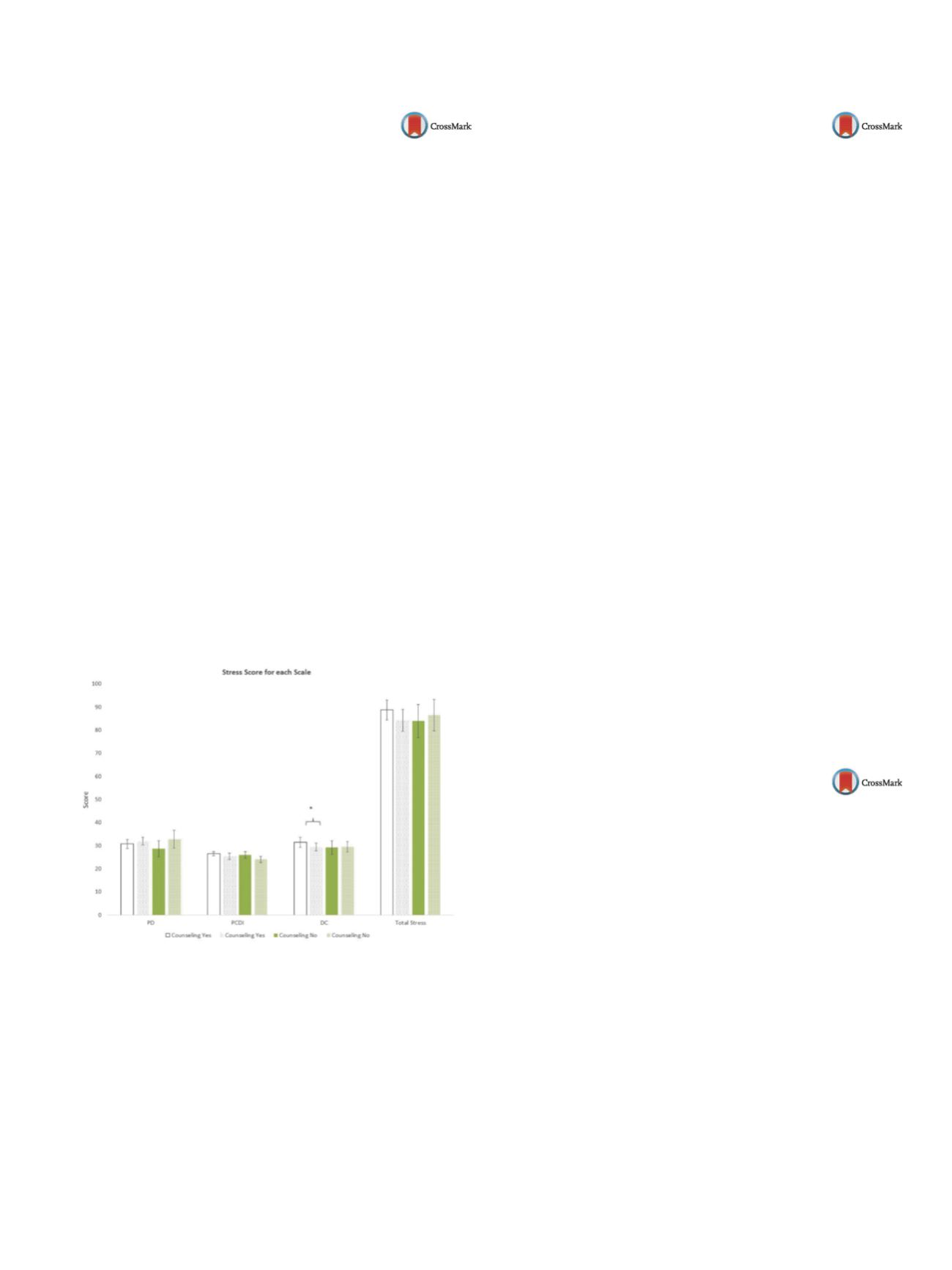

25th European Congress of Psychiatry / European Psychiatry 41S (2017) S772–S846
S787
EV1174
Parental stress in autistic parents: The
counseling effects
R. Ferrara
1 ,∗
, M. Esposito
21
École doctorale de Lausanne, Department of Biology and Medicine,
Roma, Italy
2
Università “Sapienza” di Roma, social medicine, Rome, Italy
∗
Corresponding author.
Introduction
In parents of autistic children there are high levels
of stress. For parents, counseling can help them face the world of
autism through the many stressors they experiment.
Objectives
To evidence a possible effect of the counseling inter-
vention on parental stress.
Methods
The sample consisted of 24 parents (mean age = 38.7)
of children diagnosed with autism spectrum disorder related to
the treatment centre “Una breccia nel muro”. Parents’ group was
randomly divided into two subgroups, the first (EG experimental
group) consists in 12 parents, which were included in a coun-
seling treatment of six months (one meeting of 2 hours every
15 days), while the other subgroupparents, (CGcontrol group)were
not included. We used parenting stress index–short form (PSI-SF)
before counseling intervention (T0) and after (T1) with every par-
ent. PSI values stress level in following scales: parental distress (PD),
parent-child dysfunctional interaction (PCDI) and difficult child
characteristics (DC).
Figure 1 shows all the variables in each group
at T0 and T1.
Results
Then a 2-tail t-test was separately carried out for
each group (Counseling Yes; Counseling No). Counseling Yes: PD
(t
22
= .70,
P
= .49); PCDI (t
22
= .72,
P
= .47); DC (t
22
= 2.23,
P
= .03); Tot
Stress (t
22
= 1.04,
P
= .3). Counseling No: PD (t
22
= .82,
P
= .42); PCDI
(t
22
= 1.7,
P
= .09); DC (t
22
= .59,
P
= .56); Tot Stress (t
22
= .72,
P
= .48)
Conclusions
Our data confirm the positive effects of counseling
especially on the difficulties related to children (DC scale).
Fig. 1
Disclosure of interest
The authors have not supplied their decla-
ration of competing interest.
http://dx.doi.org/10.1016/j.eurpsy.2017.01.1504EV1175
Integrating mental health care and
vocational rehabilitation to improve
return to work rates for people on
sick leave because of common mental
disorders
A. Hoff
Psychiatric Centre Copenhagen, Research Department, Hellerup,
Denmark
Introduction
Sick leave due to common mental disorders (CMD)
has major negative influence on society because of the lost produc-
tivity, social benefits, and treatment costs, and OECD estimates that
the cost is equivalent to 3.4% of the Danish gross domestic product.
Objectives
TheObjective is to examine, whether integratingmen-
tal health care with vocational rehabilitation, conveys shorter
return to work (RTW) time, compared to treatment as usual, after
sick leave due to a CMD such as depression, anxiety, and stress-
related disorders.
Aims
The aims of the intervention of are to provide the shortest
possible RTW time. Primary outcome is RTW time, and secondary
outcomes are (a) time from RTW until recurrent sick leave and (b)
symptom level a six months.
Methods
Patients are included in one of two randomized con-
trolled studies (anxiety or depression in one RCT, and stress-related
disorders in another RCT), after referral from themunicipality voca-
tional rehabilitation (VR) center, after sick leave for at least four
weeks. Patients, in both trials, are randomized into one of three
groups, in a ratio of 1:1:1: (a) control group, where they receive
treatment as usual in primary care and municipally located VR,
(b) intervention group: mental health care (MHC) in the research
project, and municipally located VR (not integrated), and (c) inter-
vention group: MHC in the research project, integrated with a
special project VR.
Results
We are currently including, and as of December 2016,
more than 300 are included. The total sample will be 1536 patients.
Disclosure of interest
The author has not supplied his/her decla-
ration of competing interest.
http://dx.doi.org/10.1016/j.eurpsy.2017.01.1505EV1176
Academic stress and emotion
regulation in the Iranian female
students with high and low academic
performance
S. Piryaei
1 ,∗
, M. Mohebbi
2, M. Khademi Ashkzari
1,
E. Khademi Ashkezari
11
Alzahra university, educational psychology, Tehran, Iran
2
Tabriz university, educational psychology, Tabriz, Iran
∗
Corresponding author.
Introduction
This paper examines the similarities and differences
between academic stress and emotion regulation and investigates
that the association between emotion regulation and academic
stress may be explained the level of academic success among
female students.
Objectives
This research suggests that students vary in their abil-
ity to regulate emotions and cope with academic stress, and these
abilities may differ across the level of student’s academic success.
Identifying the academic stress and quality of emotion regulation
strategieswill lead topractical implications for promoting student’s
with low or high academic success.
Aims
The present study aims to compare academic stress and
emotion regulation in the female students with high and low aca-
demic performance.
Methods
A total of 162 high school students (mean age = 15.26)
were selected by cluster random sampling method. They were cat-


















